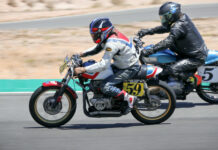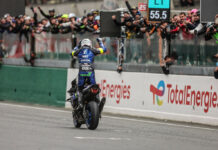Moto Marin, a BMW dealership located in San Rafael, California, invited Dave Williams and Dave Moss out to Infineon Raceway to vicariously experience the new S1000RR Superbike with BMW Motorrad “Ambassador” Gary Hardin. Be sure to check out other Roadracing World feature videos. Video provided by ~http://www.OnTheThrottle.tv~ BMW S1000RR FIRST ENCOUNTER By Dave Williams You’ll notice this is not titled, “First Ride.” That’s because BMW Motorrad currently has just three S1000RR models here in the mighty US of A, and won’t allow anyone but their two sanctioned “Ambassadors” ride the things. The Western States Ambassador, Gary Hardin, is an American club racer of some renown. His lap times at Infineon Raceway, a track he had never seen before and the site of our Close Encounter Of A Deutsch Kind, indicate he is a solid mid-pack racer. Add to that a desperate desire NOT to wad up some German engineering and you’ve got a recipe for the average joe riding a solid B group trackday pace. This is good, because he’s actually more like us than, say, Troy Corser. I’m 5’8″ tall and weigh 170 lbs. Yoshimura pilot Blake Young is also 5’8″ but weighs a paltry 135 lbs. You can see in the video that accompanies this article that Gary Hardin is more like me than he is like Blake Young. Bear in mind that Mr. Hardin is also the BMW U.S. demo fleet manager, which likely influences his comments regarding the S1000RR sportbike. This isn’t a tech briefing, this is a real-world encounter. That being said, we now turn our attention to Dave Moss of Catalyst Reaction Suspension who worked closely with Hardin throughout the trackday at Infineon Raceway. Moss may slip into warp-drive geek speak, but I will translate that where necessary. It should be noted that in spite of Ambassador Hardin calling his S1000RR a “track only” bike, it did have headlights, taillights, fenders, etc. We think what he really meant was, it was a prototype that hasn’t yet been certified by the U.S> government for street use. Over to Dave Moss: OnTheThrottle and Catalyst Reaction Suspension Tuning were given access to this flagship model in order to film the bike. We worked through some suspension, geometry, and riding style changes with BMW Ambassador Gary Hardin during a trackday hosted by Lance Keigwin and Keigwins at the Track. Dealer Principle Cary Littell of Moto Marin in San Rafael, California gave us a first look around the extremities of the “prototype” track-only bike prior to the trackday. The bike had clearly been adjusted from its factory suspension settings and we recorded the following: Fork Height: 15mm above the triple clamp. Fork Preload: Maxxed at 10.5 turns in. Fork Rebound: At the #10 setting. Fork Compression: At the #7 setting. Fork Piston: 30mm diameter. Shock Height: Appeared to be the factory setting. Shock Preload: Three threads showing above the allen-bolt-secured lock ring. Shock High Speed Compression: At the #3 setting. Shock Low Speed Compression: At the #4 setting. Shock Rebound: At the #9 setting. Shock Piston: 46mm diameter The bike’s compression and rebound damping adjusters are “clickers” with a range of 1 to 10 clicks where #1 was the softest and #10 the hardest. The gearing appeared to be stock. The tires were Pirelli Diablo Super Corsas, the SC3 compound. Once at the track I set all the hydraulic damping adjusters to the #5 setting as a neutral starting point, except for the shock’s High Speed Compression which I set at #1. I left the Fork Preload at full stiff and then sat Gary on the bike to measure sag. I found the following. Forks: Full travel possible was 120mm. With Gary on the bike, Total Sag was 40mm. Again, all 10.5 turns of preload were installed so none could be added. Shock: Full travel possible was 130mm. Free Sag was 20mm and Gary’s weight added another 25mm for a Total Sag of 45mm. I added two turns of preload to set Total Sag at 35mm. Session One I borrowed a 2006 K12R that had been heavily modified with all the BMW Power Cup add-ons especially with regard to rear chassis geometry, and Gary and I went out on the track (I was comparatively way down on power so I needed all the help I could get!). We rode a lead follow session for the entire 20 minutes slowly decreasing lap times to get Gary comfortable. Wherever possible I gave the K12R full throttle to see how quickly the S1000RR would appear in my mirrors prior to the brake markers. It filled the mirrors very quickly. At the end of the session with the bike hot, I balanced the S1000RR’s rebound by setting the fork and shock rebound circuits to #10. Session Two Gary went out for his first solo session, focusing for me on overall chassis balance in Turn Six (The Carousel). He returned reporting excellent overall balance with no pogo and no handlebar “rowing” at all. He did complain about rear squat under hard acceleration, so I added one turn of shock preload to minimize the squat (mostly due to the large amount of free sag) and I added two clicks of Low Speed Compression damping, from #5 to #7. Session Three I asked Gary to concentrate on Turns Two and Seven, to be consistent in throttle application at the same time/place in each of these corners and determine if the bike would fade wide or even run wide under increasing acceleration. He could therefore evaluate how my changes affected his drive off the corners. Upon his return I could see some adverse wear patterns on the rear tire. To remedy this I softened the High and Low Speed Compression settings in the shock to #1 to give it more stroke and de-stress the tire. Session Four Taken out of the mix due to Gary’s self-proclaimed inconsistent riding. Session Five I asked Gary to concentrate on braking for Turns Nine and11 to evaluate brake dive and rear wheel instability. These turns have topographical features that challenge both rider and chassis. To help compensate for this, I increased fork Compression damping two clicks, from #5 to #7. Even under Gary’s hardest braking the rear wheel did not lift and the forks did not bottom out mechanically. Rear tire wear had improved dramatically, but was still not acceptable. In my trackside observations I noticed Gary often short-shifted rather than letting the engine rev out, so I asked him to let the rpm climb much higher before shifting. Session Six Gary did indeed stop short-shifting and let the bike rev to peak power. Consequently Gary said the S1000RR handled even better as the engine ran through to peak power. He also said it finished corners with precision and required far less effort to get around the track. The rear tire improved to the point that there was no further tearing at all. At this juncture I would normally flip the Diablo Super Corsa knowing that the tire wear was optimized, and send the rider back out, but there wasn’t enough time remaining. Session Seven Gary did not ride the last session of the day due to crowds surrounding the bike, his compelling PR duties, and the sun having passed over the yard arm. Below is a list of things I noted about the S1000RR as I worked on it throughout the day. 1. The handlebars have no sweep adjustability, even though they have the same type of cast dowel as a Suzuki does. It would be great to have a small arc in the upper triple clamp casting to be able to move the bars back and forth by 10mm. 2. Brake lever adjustability had six settings, but the clutch lever was not adjustable. 3. The clutch lever was cable operated for better feel when downshifting and decelerating. 4. The rearsets were not adjustable at the frame mounts, and the exhaust bracket was fixed to the right rearset. The footpeg feelers didn’t touch the ground once, even in the off camber corners. (In photos from World Superbike races, the bike has different rearsets and a different exhaust mount to the subframe). 5. There was, however, good adjustability in the foot controls. 6. The stock shift mechanism will not allow for easily reversing the shift pattern, because the shift rod goes through the frame. An optional shift drum has to be installed to reverse the shift pattern. 7. The optional OEM quick-shifter upgrade from BMW was installed, and the ECU mode was set to Sport. 8. I did not get to ride the bike and test the chassis/suspension settings for myself. 9. The were no spools on the swingarm for a rear stand. 10. The steering stem was blocked by a three-way brake line fitting which will prevent the use of a steering-stem or head-stock front stand.
Tuesday Video: A Trackside Encounter With A BMW S1000RR Sportbike, At Infineon Raceway
Tuesday Video: A Trackside Encounter With A BMW S1000RR Sportbike, At Infineon Raceway
© 2009, Roadracing World Publishing, Inc.





